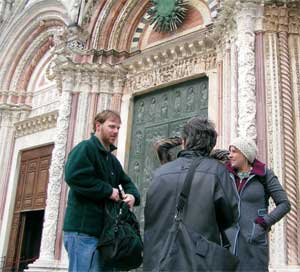
| Immersed in History: Teaching Under the Block Plan | |
| by Susan Ashley |
 |
| Left, Dan Roose ’04, who accompanied the Renaissance Worlds seminar to Italy, waits at the door to the Duomo in Siena with, from left, Susan Ashley (back to camera), Emily Auerbach ’05, and Joe Schaedler ’05 (behind Ashley). |
| Photo by Julie Nichols ’05 |
Two weeks earlier, in Palmer Hall, the advanced seminar Renaissance Worlds listened to brief reports on the catasto of 1427, a census ordered by the Florentine republic. With the help of Marla Gerein, academic technology specialist for social sciences, students learned to manipulate data to answer a series of questions they devised about 15th-century Florentine society. How did wealth correlate to family size? (The richer the family, the larger the household.) Did urban geography reflect certain occupations and income levels? (To a very limited extent.)
Then we left for Italy (with most of the expenses covered by history department endowment funds). We spent the remainder of the class in Florence, with a day in Siena and four days in Venice. Was the class exceptional? In every way. Fifteen seniors studied the Renaissance by discussing primary texts and examining public spaces, buildings, and art. We did history where it happened. “I loved that I could physically see something and then later go to my room and read about how it was created, who participated, who paid,” said Morgan Turnbow ’05.
Other history classes leave campus as well. History Professor Peter Blasenheim and English Professor Joan Stone combined to teach about poet Elizabeth Bishop’s life in Brazil. Professor Anne Hyde takes her classes to the Southwest. Such classes happen infrequently, but the usual history classes — those taught on campus — are also unique. Think of the typical college or university history course; a professor behind the lectern dispensing information to a packed lecture hall comes to mind. That image does not apply to history taught under the Block Plan.
The small size of the classes makes every class a potential seminar. And the one-class-at-a-time format means faculty can assign a lot of reading — enough to generate the confusion that promotes good discussion. While it’s hard to “finish” a discussion of Plato or Mencius or the causes of the Civil War, you can get much further in three hours than you can in the 50 minutes common in semester systems. Moreover, the next day you pick up where you left off; each class reinforces the last. That kind of continuity and momentum would be hard to achieve meeting just three times a week.
Knowing that students take only one class also makes it easier to ask them to write. These days, electronic journaling adds to more conventional analytical essays and research papers. The intense pace of the block forces students to do research efficiently and to write with fluidity. These qualities make writing their senior essays or theses a little easier. Students concentrate the research in a block or two, but the work usually takes them the entire year. The chance to do a large, long-term project complements the brevity of blocks.
History asks students to examine multiple facets of human experience across time and cultures. The complexity of the enterprise calls for exactly the sort of flexibility and intense focus that the Block Plan permits. More importantly, the small class size and the length of class sessions draw students directly into the learning process. In this way, remote eras and places become immediate.
Susan Ashley is professor of history and dean of the college/dean of the faculty.
Here's one of 35 facts about CC:
5
The average class size at CC is about 13.
The Colorado College | 14 East Cache La Poudre Street | Colo Sprgs, CO | 80903 | 719-389-6000